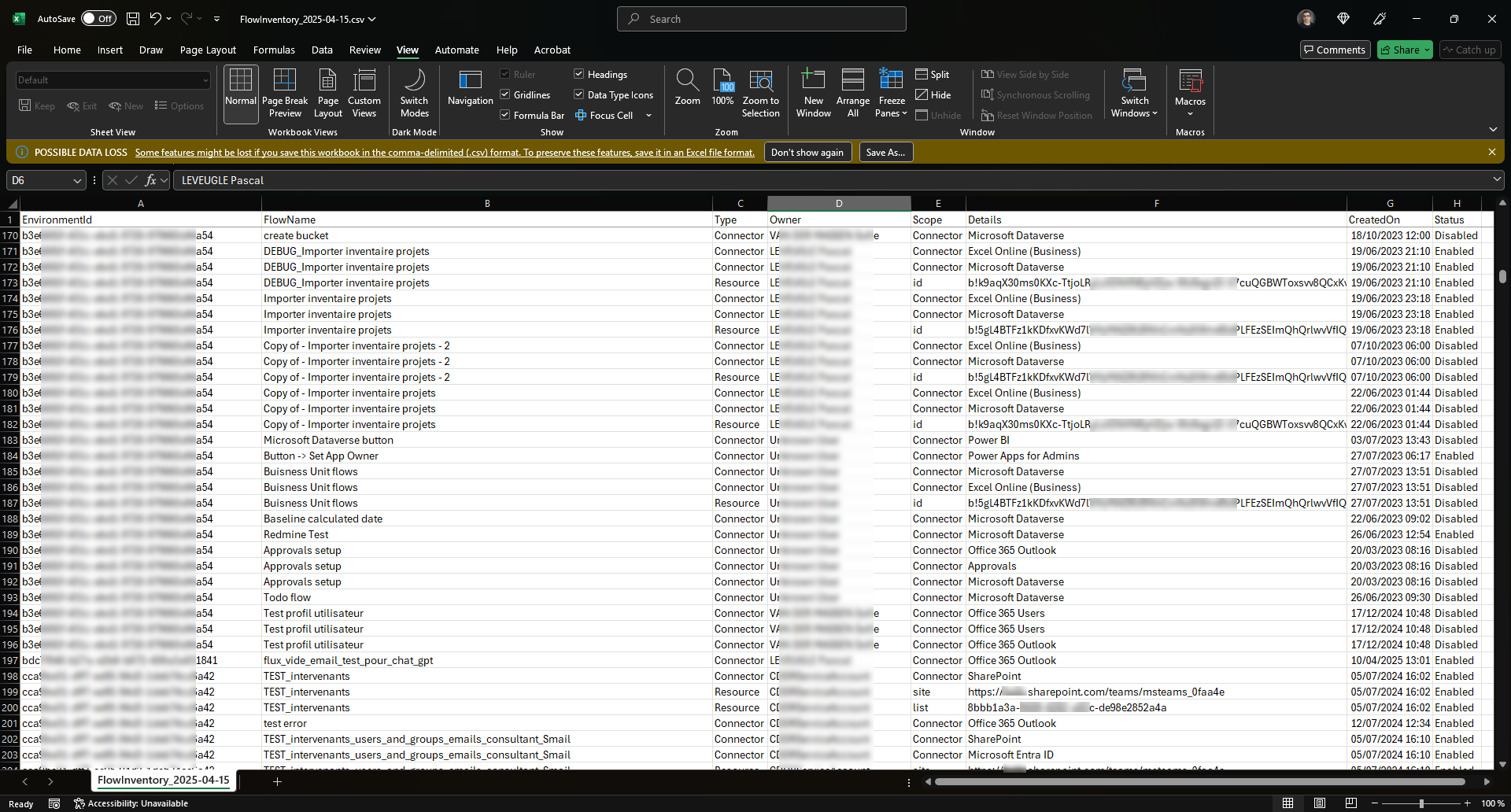Inventory Power Automate Flows with SharePoint, Connectors, and Owners
If you manage Microsoft Power Platform environments across your organization, getting a clear view of your Power Automate flows can be a challenge. Who owns them? Which connectors are in use? Are flows connected to SharePoint lists or document libraries?
This PowerShell script helps you generate a complete inventory of flows across all environments, including:
- The environment ID
- The Flow Name
- The owner of each flow
- The Type of item line :
- Connector used by the flow
- Resource depending on one of the connectors
- The connectors used (like SharePoint, Outlook, etc.)
- Referenced resource depending on the connector : SharePoint sites, lists, and files ID (when applies) - this will produce additional line(s) if data is available
- The flow status (enabled/disabled)
- The creation date of each flow
The result is exported into a CSV file with a timestamped filename for easy tracking and archiving.

How the Script Works
1. Module Verification
The script first checks for required PowerShell modules:
-
Microsoft.PowerApps.Administration.PowerShell -
Microsoft.Graph.Users
If they're missing, it installs them automatically.
2. Interactive Login
The user is prompted to log into:
-
Power Platform Admin Center (
Add-PowerAppsAccount) -
Microsoft Graph API (
Connect-MgGraphwithUser.Read.Allscope)
3. Flow Extraction
The script retrieves all flows using Get-AdminFlow and loops through them. For each flow:
-
It collects the environment name, creation date, and status
-
It tries to resolve the user's display name based on the used id from Microsoft Graph.
Value is set to Unknown User if the user is not found. -
It extracts the connectors in use
-
It looks for referenced SharePoint resources, keeping unique values only and filtering out placeholders like
[DYNAMIC_VALUE]
4. Progress Feedback
During execution, the script displays a real-time percentage to track the progress of the export.

5. CSV Export
All results are exported to a CSV file named like FlowInventory_2025-04-15.csv in the current directory.
The Script
Below is the full PowerShell script you can use or adapt:
# Check and install required modules if missing
$requiredModules = @(
"Microsoft.PowerApps.Administration.PowerShell",
"Microsoft.Graph.Users"
)
foreach ($module in $requiredModules) {
if (-not (Get-Module -ListAvailable -Name $module)) {
Write-Host "📦 Installing required module: $module" -ForegroundColor Yellow
Install-Module -Name $module -Scope CurrentUser -Force -AllowClobber
}
}
Import-Module Microsoft.PowerApps.Administration.PowerShell
Import-Module Microsoft.Graph.Users
# Login
Write-Host "`n🔐 Connecting to Power Platform..." -ForegroundColor Cyan
Add-PowerAppsAccount
Write-Host "🔐 Connecting to Microsoft Graph..." -ForegroundColor Cyan
Connect-MgGraph -Scopes "User.Read.All"
$Results = @()
$Flows = Get-AdminFlow
$totalFlows = $Flows.Count
$flowIndex = 0
foreach ($Flow in $Flows) {
$flowIndex++
$progressPercent = [math]::Round(($flowIndex / $totalFlows) * 100)
Write-Host "Processing flow $flowIndex / $totalFlows ($progressPercent%) - $($Flow.DisplayName)" -ForegroundColor DarkGray
$EnvironmentId = $Flow.EnvironmentName
$FlowName = $Flow.DisplayName
$CreatedOn = $Flow.CreatedTime
$Status = if ($Flow.Enabled -eq $true) { "Enabled" } else { "Disabled" }
try {
$FlowInfo = Get-AdminFlow -FlowName $Flow.FlowName -EnvironmentName $EnvironmentId
} catch {
Write-Host "⚠️ Failed to retrieve flow details: $FlowName" -ForegroundColor Red
continue
}
try {
$user = Get-MgUser -UserId $FlowInfo.CreatedBy.objectId -ErrorAction Stop
$FlowOwner = $user.DisplayName
} catch {
$FlowOwner = "Unknown User"
}
$ConnectorDisplayNames = $FlowInfo.Internal.properties.connectionReferences.PSOBJECT.Properties.value.displayname
foreach ($dspname in $ConnectorDisplayNames) {
$Results += [pscustomobject]@{
EnvironmentId = $EnvironmentId
FlowName = $FlowName
Type = "Connector"
Owner = $FlowOwner
Scope = "Connector"
Details = $dspname
CreatedOn = $CreatedOn
Status = $Status
}
}
$ConnectorResourceList = $FlowInfo.Internal.properties.referencedResources.resource
foreach ($resource in $ConnectorResourceList) {
if ($resource.site) {
$Results += [pscustomobject]@{
EnvironmentId = $EnvironmentId
FlowName = $FlowName
Type = "Resource"
Owner = $FlowOwner
Scope = "site"
Details = $resource.site
CreatedOn = $CreatedOn
Status = $Status
}
}
if ($resource.list) {
$Results += [pscustomobject]@{
EnvironmentId = $EnvironmentId
FlowName = $FlowName
Type = "Resource"
Owner = $FlowOwner
Scope = "list"
Details = $resource.list
CreatedOn = $CreatedOn
Status = $Status
}
}
if ($resource.fileid) {
$Results += [pscustomobject]@{
EnvironmentId = $EnvironmentId
FlowName = $FlowName
Type = "Resource"
Owner = $FlowOwner
Scope = "id"
Details = $resource.fileid
CreatedOn = $CreatedOn
Status = $Status
}
}
}
}
# Export with date-stamped filename
$DateStamp = Get-Date -Format "yyyy-MM-dd"
$ExportPath = ".\FlowInventory_$DateStamp.csv"
$Results | Export-Csv -Path $ExportPath -NoTypeInformation -Encoding UTF8BOM -Delimiter ";"
Write-Host "`n✅ Export completed: $ExportPath" -ForegroundColor Green
Next Steps
You can now import this CSV into Excel or Power BI to:
-
Track unused or orphaned flows
-
Identify flows using deprecated connectors
-
Audit SharePoint dependencies
-
Group flows by owner or environment
For automation, this script can also be scheduled via Task Scheduler or integrated into a compliance workflow.
🙌 Hope You Found This Useful
We hope you enjoyed this article and that the script helps you gain better visibility into your Power Automate flows.
If you have any questions, feedback, or suggestions for improvements, feel free to leave a comment below — we’d love to hear from you!


